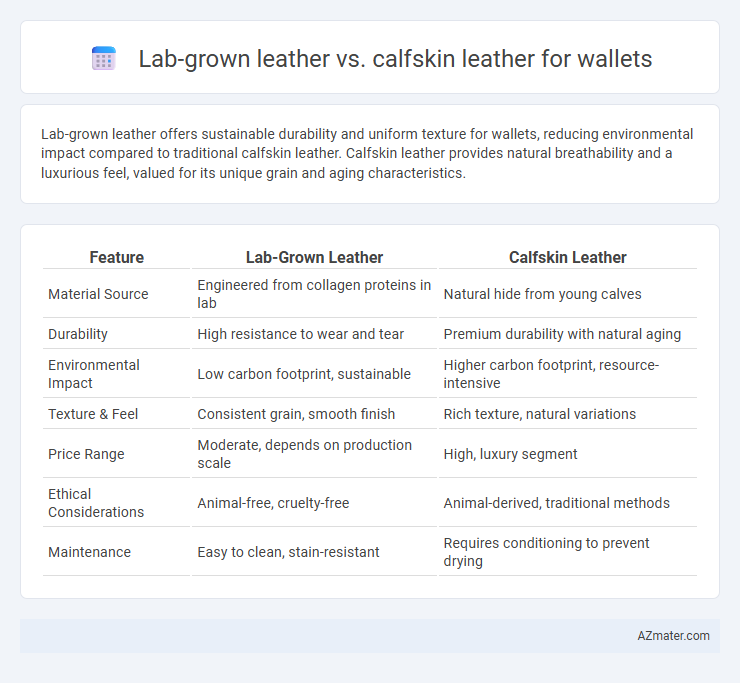Lab-grown leather offers sustainable durability and uniform texture for wallets, reducing environmental impact compared to traditional calfskin leather. Calfskin leather provides natural breathability and a luxurious feel, valued for its unique grain and aging characteristics.
Table of Comparison
| Feature | Lab-Grown Leather | Calfskin Leather |
|---|---|---|
| Material Source | Engineered from collagen proteins in lab | Natural hide from young calves |
| Durability | High resistance to wear and tear | Premium durability with natural aging |
| Environmental Impact | Low carbon footprint, sustainable | Higher carbon footprint, resource-intensive |
| Texture & Feel | Consistent grain, smooth finish | Rich texture, natural variations |
| Price Range | Moderate, depends on production scale | High, luxury segment |
| Ethical Considerations | Animal-free, cruelty-free | Animal-derived, traditional methods |
| Maintenance | Easy to clean, stain-resistant | Requires conditioning to prevent drying |
Introduction: Lab-Grown Leather vs Calfskin Leather
Lab-grown leather offers a sustainable alternative to traditional calfskin leather by using bioengineered materials that replicate the texture and durability of animal hide without involving livestock. Calfskin leather is prized for its natural grain, softness, and long-lasting strength, making it a premium choice for wallets in luxury fashion. Comparing lab-grown leather and calfskin highlights differences in environmental impact, cost, and tactile experience, crucial factors for consumers seeking ethical and high-quality leather products.
Material Origins: How Each Leather is Made
Lab-grown leather is created through a biofabrication process using cultured animal cells or plant-based materials, eliminating the need for animal slaughter while maintaining a leather-like texture. Calfskin leather originates from the hides of young cattle, undergoing tanning and finishing treatments to achieve its durability and smooth finish. The fundamental difference in material origins lies in lab-grown leather's synthetic cultivation versus calfskin's traditional animal-derived sourcing.
Sustainability and Environmental Impact
Lab-grown leather offers a sustainable alternative to calfskin leather by eliminating the need for animal farming, significantly reducing greenhouse gas emissions, water consumption, and land use. Calfskin leather production involves intensive resource use and contributes to deforestation, pollution from tanning chemicals, and ethical concerns related to animal welfare. Choosing lab-grown leather for wallets supports reduced environmental impact while maintaining durability and the aesthetic qualities of traditional leather.
Durability and Longevity Compared
Lab-grown leather exhibits high durability due to its engineered fibers that resist cracking and fading, making it increasingly comparable to traditional calfskin leather. Calfskin leather offers proven longevity with natural toughness and develops a unique patina over time, enhancing its aesthetic appeal and durability. Advances in lab-grown leather technology are closing the gap, offering sustainable wallets that maintain structural integrity and wear resistance similar to high-quality calfskin.
Texture and Aesthetic Differences
Lab-grown leather offers a smooth, consistent texture with customizable finishes, providing a contemporary and uniform aesthetic ideal for sleek wallet designs. Calfskin leather boasts a naturally rich grain and varied texture that evolves with use, delivering a classic, luxurious appearance prized in premium wallets. The tactile experience of calfskin is often described as supple and warm, while lab-grown leather tends to be more uniform and cooler to the touch, reflecting their different material origins.
Cost Analysis: Affordability and Value
Lab-grown leather wallets offer a more cost-effective option compared to traditional calfskin leather, with production costs often reduced by up to 40%, making them more affordable for budget-conscious consumers. Calfskin leather provides long-lasting durability and a luxurious feel that can justify its higher price point, often ranging from $100 to $300 per wallet, while lab-grown leather typically falls between $50 and $150. The value of lab-grown leather lies in sustainable and cruelty-free production without compromising style, appealing to eco-conscious buyers seeking affordability without sacrificing quality.
Ethical Considerations for Consumers
Lab-grown leather offers a sustainable and cruelty-free alternative to traditional calfskin leather, eliminating animal harm and reducing environmental impact through less resource-intensive production. Consumers concerned with animal rights and ecological footprints increasingly prefer lab-grown options, which avoid the ethical dilemmas associated with livestock farming and tanning processes that involve toxic chemicals. Ethical considerations highlight lab-grown leather as a forward-thinking choice that aligns with principles of animal welfare and sustainable consumption in wallet manufacturing.
Maintenance and Care Requirements
Lab-grown leather requires less maintenance than calfskin leather, as it resists water stains and does not develop patina or scuff marks over time, making it easier to clean with a damp cloth. Calfskin leather demands regular conditioning with specialized leather care products to maintain its softness, prevent cracking, and preserve its natural texture and sheen. Both materials benefit from avoiding prolonged exposure to direct sunlight and moisture, but calfskin leather's natural fibers necessitate more diligent care routines to ensure durability in wallet usage.
Market Availability and Popular Brands
Lab-grown leather wallets are increasingly available through innovative brands like Modern Meadow and Bolt Threads, appealing to eco-conscious consumers with their sustainable production methods. Calfskin leather remains widely dominant, with established luxury brands such as Gucci, Louis Vuitton, and Hermes offering premium calfskin wallets known for durability and classic appeal. Market availability favors calfskin leather due to its longstanding industry presence, while lab-grown leather is rapidly gaining traction in niche markets focused on ethical and environmental considerations.
Choosing the Right Leather for Your Wallet
Lab-grown leather offers a sustainable and animal-friendly alternative to traditional calfskin leather, providing similar durability and texture with reduced environmental impact. Calfskin leather remains prized for its natural grain, softness, and long-lasting quality, often preferred for luxury wallets that develop a unique patina over time. Choosing the right leather for your wallet depends on your values regarding sustainability, budget, and desired aesthetic, with lab-grown leather excelling in eco-conscious appeal and calfskin delivering classic sophistication.

Infographic: Lab-grown leather vs Calfskin leather for Wallet
 azmater.com
azmater.com